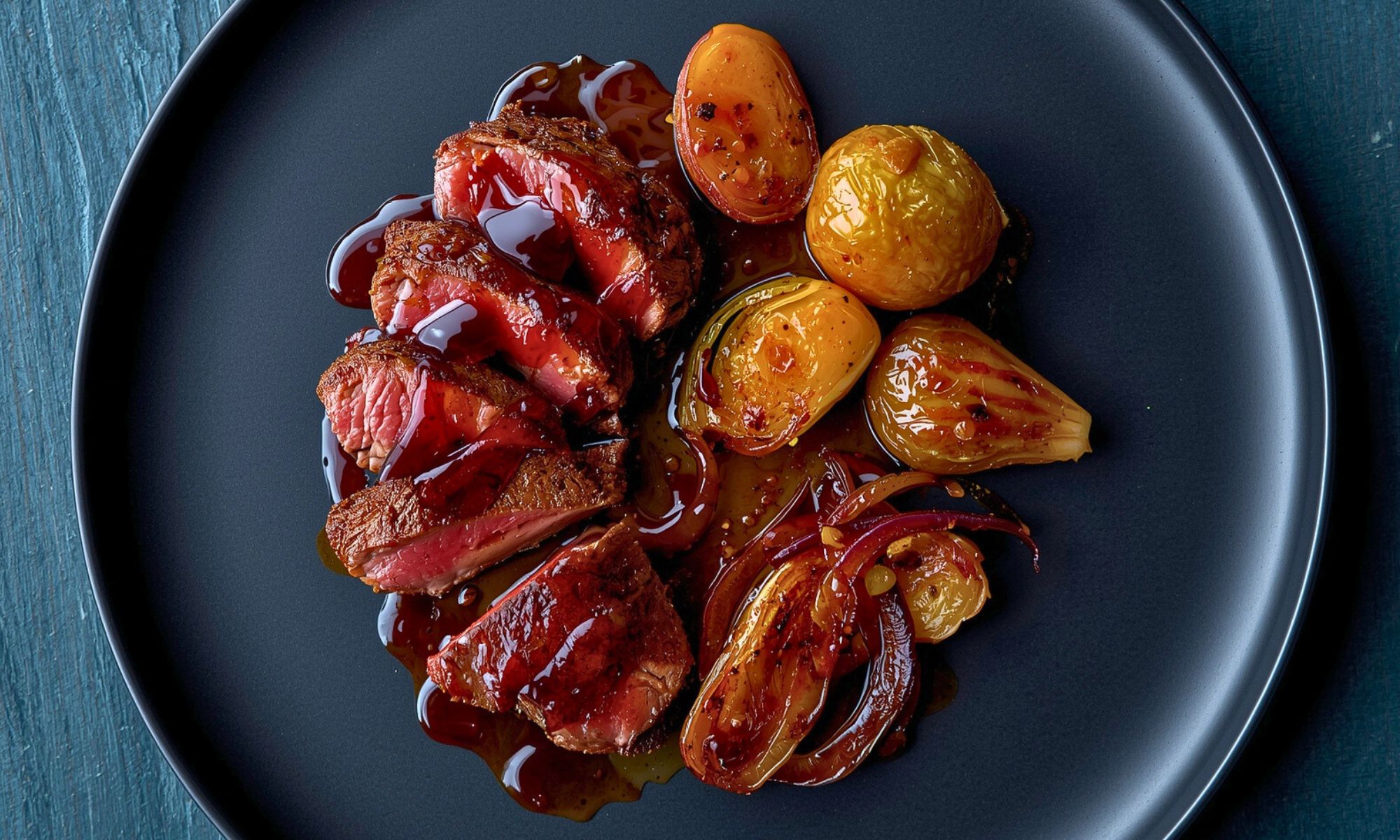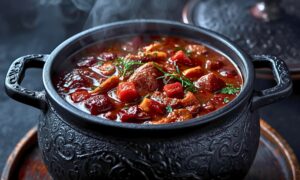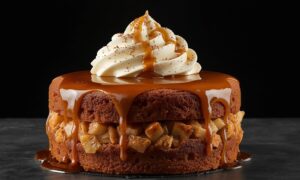Beloved Cherry Balsamic Sirloin isn’t just dinner, it’s a statement. Sweet, tangy, and perfectly seared, this easy steak recipe blends bold flavor with a modern, elevated twist. Think weeknight convenience meets restaurant quality elegance, ready to impress without demanding hours in the kitchen.
I didn’t set out to reinvent steak night, but the moment cherry preserves and balsamic vinegar collided in my pan, I knew this was more than a happy accident. The sauce transformed into a glossy, tangy sweet balsamic glaze that clung to each slice of perfectly cooked sirloin like it belonged there all along. Add in golden herbed fingerlings and caramelized Brussels sprouts, and suddenly the whole plate spoke in textures, crisp, juicy, tender, vibrant.
This Cherry Balsamic Sirloin isn’t about fuss or tradition, it’s about letting a few smart choices turn simple ingredients into something unforgettable. In the next few steps, I’ll show you how to build flavor from the pan up, coax natural sweetness without losing balance, and bring every element together so the first bite makes you pause. Whether you’re planning a weeknight dinner or hosting friends, this easy steak recipe delivers gourmet flavor at home, trust me, it’s one you’ll make on repeat.
What Makes Cherry Balsamic Sirloin Special
The genius of Cherry Balsamic Sirloin lies in the contrast. Sirloin’s robust, beefy flavor gets this gorgeous fruity kiss that doesn’t mask the meat, it enhances every single bite. The balsamic brings that acidic edge that cuts through richness while the cherries add natural sweetness and a pop of color that makes your plate look like it came from a five star kitchen.
Here’s what most people don’t realize about this combination. Fresh cherries have natural enzymes that help tenderize the meat while they cook. The balsamic’s acidity does the same thing. You’re basically giving your Cherry Balsamic Sirloin a flavor bath that makes it more tender and infinitely more interesting.
The technique itself breaks every rule your cooking teacher probably told you. We’re gonna sear first, then create the sauce right in the same pan. No separate sauce making. No complicated reductions. Just pure, concentrated flavor that builds layer by layer until the Cherry Balsamic Sirloin reaches absolute perfection.
Ingredients That Actually Matter
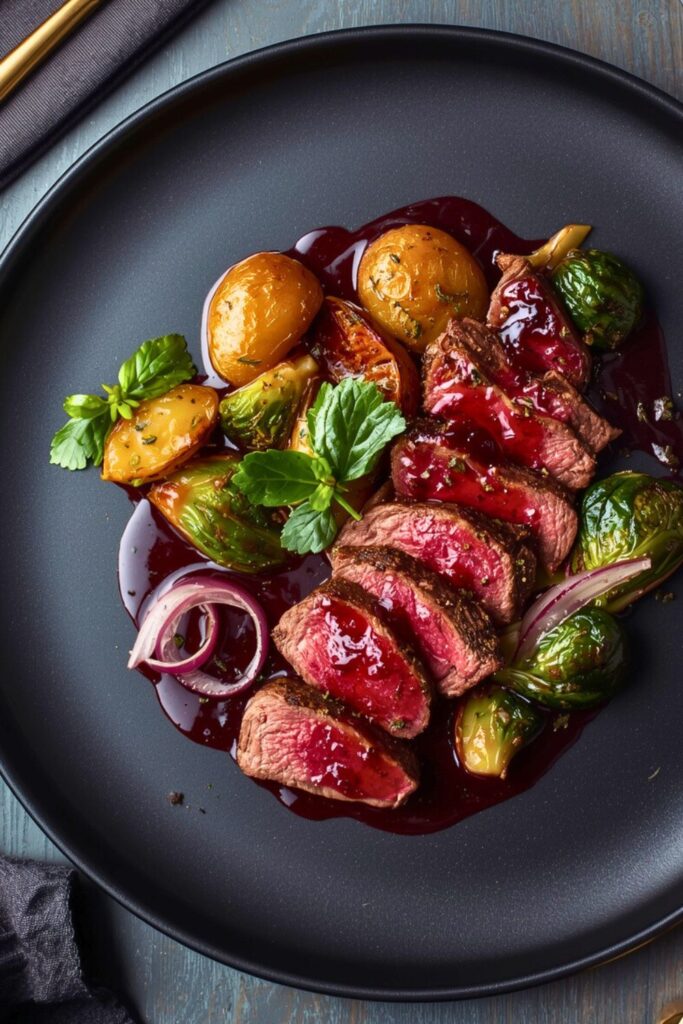
For the Sirloin:
- 4 sirloin steaks (about 6 oz each, 1-inch thick)
- 2 tablespoons olive oil
- Salt and freshly cracked black pepper
- 2 cloves garlic, minced
For the Cherry Balsamic Magic:
- 1 cup fresh cherries, pitted and halved (or 3/4 cup dried cherries, rehydrated)
- 1/3 cup good balsamic vinegar (don’t cheap out here)
- 2 tablespoons honey
- 1 shallot, finely diced
- 1/2 cup beef broth
- 2 tablespoons cold butter
- Fresh thyme sprigs
Let’s talk smart swaps because not everyone lives next to a gourmet market. Can’t find fresh cherries? Frozen ones work perfectly, just thaw and drain them first. Those fancy $30 balsamics? Save your money. A decent $8-12 bottle will do the job beautifully.
Living somewhere that fresh cherries cost a fortune? Here’s my secret weapon: good quality cherry preserves. Use about 1/4 cup and reduce the honey to 1 tablespoon. The result’s gonna will be slightly sweeter but equally delicious.
No beef broth on hand? Chicken broth works fine. Red wine? Even better if you’ve got an open bottle sitting around. The key is having some liquid to deglaze all those gorgeous brown bits from the pan.
The Step by Step Magic of Beloved Cherry Balsamic Sirloin
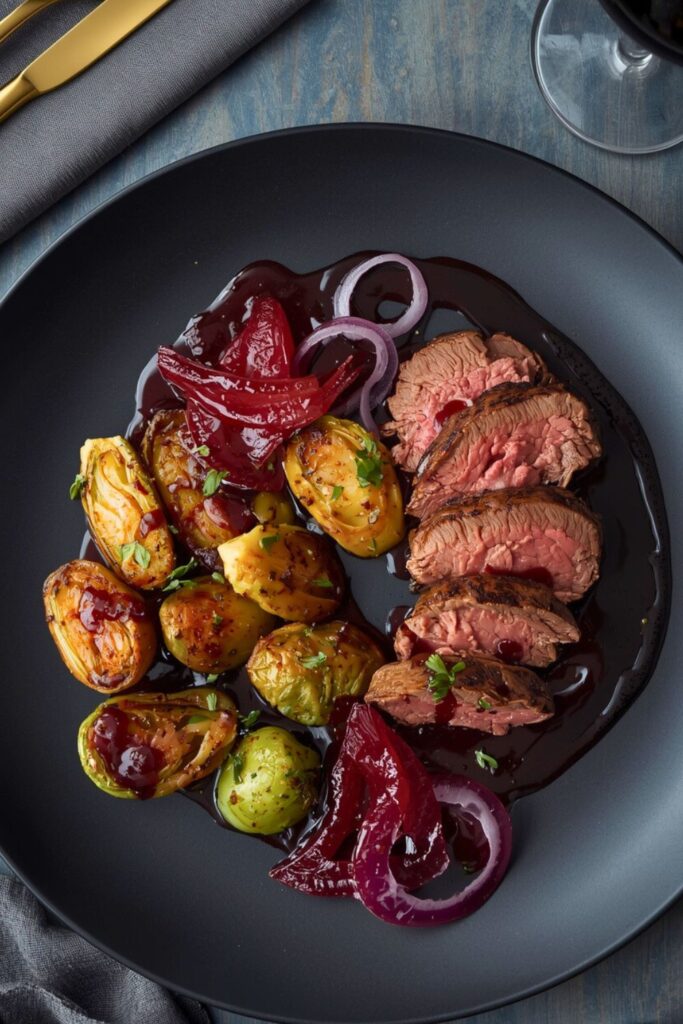
Getting Started Right: Take your steaks out of the fridge 20 minutes before cooking. Cold meat + hot pan = uneven cooking. Season them generously with salt and pepper while they’re coming to room temperature.
Heat your olive oil in a large skillet over medium high heat until it shimmers. Not smoking, that’s too hot. We want a good sear, not burnt offerings.
The Searing Secret: Place steaks in the pan and resist every urge to move them. I know it’s tempting, but that gorgeous crust only forms when you leave them alone. About 3-4 minutes per side for medium rare, depending on thickness.
Here’s where most people mess up, they keep flipping. Don’t. One flip. That’s it. Let the heat do its job.
Remove steaks to a plate and tent with foil. They’ll continue cooking while we build the sauce.
Building the Sauce Like a Pro: In the same pan (don’t clean it, those brown bits are flavor gold), add your diced shallot. Cook for about a minute until fragrant.
Add the cherries and let them soften for 2-3 minutes. They’ll start releasing their juices, which is exactly what we want.
Pour in the balsamic vinegar and honey. This is where the magic happens. You’ll see the mixture bubble and reduce immediately. Let it cook for 2-3 minutes until it gets slightly syrupy.
Add the beef broth and scrape up all those beautiful browned bits from the bottom of the pan. This is called deglazing, and it’s where half your flavor comes from.
Let everything simmer for 3-4 minutes until the sauce reduces by about half. It should coat the back of a spoon lightly.
The Finishing Touch: Remove from heat and whisk in the cold butter, one piece at a time. This creates that glossy, restaurant quality finish that makes people think you’re way fancier than you actually are.
Nestle the steaks back into the sauce for just a minute to warm through. Garnish with fresh thyme and serve immediately.
The Science Behind This Sweet Success
Why does this combination work so brilliantly? It’s all about balance and chemistry. The natural sugars in cherries caramelize when they hit the hot pan, creating complex flavors that taste way more sophisticated than the simple ingredient list suggests.
Balsamic vinegar isn’t just any acid. It’s been aged and concentrated, which means it has these deep, almost wine like flavors that complement beef beautifully. The acidity brightens the dish while the natural sweetness plays perfectly with the cherries.
That butter we whisk in at the end? It’s not just for richness. It’s an emulsifier that brings the sauce together and gives it that glossy, professional appearance. Skip it and your sauce will taste good but look flat.
The pan choice matters more than you think. A heavy bottomed skillet holds heat evenly, which means better searing and more controlled sauce making. Those thin pans from college? They’ll give you hot spots and burnt bits in all the wrong places.
Making It Look Like a Million Bucks
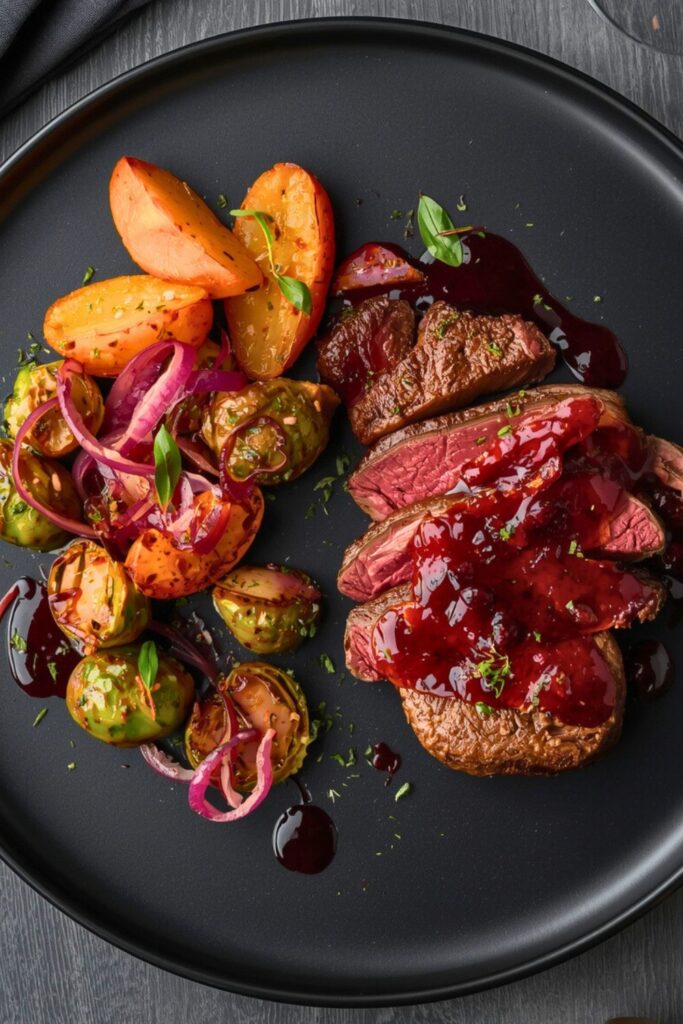
Presentation isn’t about fancy plating, it’s about making food look as good as it tastes. Slice your steak against the grain at a slight angle. This not only looks more elegant but actually makes each bite more tender.
Pool some of that gorgeous cherry balsamic sauce on the plate first, then arrange the sliced steak on top. Make sure the sauce looks glossy and jewel toned. If it seems too thick, thin it with a splash of broth.
Those fresh thyme sprigs aren’t just garnish, they add aroma that hits your nose before you take the first bite. Fresh herbs always make a dish look more expensive than it actually was.
Want to really impress? Serve this with roasted Brussels sprouts or asparagus. The slight bitterness of the vegetables plays beautifully against the sweet tangy sauce. Creamy mashed potatoes work too, but honestly, this Cherry Balsamic Sirloin is rich enough to stand on its own with just a simple green salad.
For wine pairing, you’d think red, but a good Pinot Noir or even a rich Chardonnay works beautifully. The fruit flavors in both wines echo the cherries while standing up to the beef.
Bringing It All Together
This Cherry Balsamic Sirloin proves that impressive doesn’t have to mean complicated. You’re working with maybe six real ingredients, one pan, and about 20 minutes of actual cooking time. But the flavors you create are restaurant worthy.
The best part? Once you master this technique, you can swap the cherries for other fruits. Try it with fresh figs in fall, or strawberries in spring. The method stays the same, but you get completely different flavor profiles.
Remember that confidence in the kitchen comes from understanding why things work, not just following steps blindly. You now know why we sear first, why we deglaze, why we finish with butter. That knowledge makes you a better cook with every dish you make.
Next time you’re standing in the grocery store wondering what to make for dinner that’ll actually impress people, grab some sirloin and fresh cherries. Your kitchen’s about to smell like heaven, and your family’s gonna think you’ve been hiding some serious cooking skills.
Beloved Cherry Balsamic Sirloin: Q&A
Can I use frozen cherries instead of fresh?
Absolutely, and they might even be better in some cases. Frozen cherries are picked at peak ripeness and flash frozen, so they’re often more flavorful than off season fresh ones. Just thaw them completely and drain off excess liquid before using. You’ll get the same great results.
What if my balsamic sauce gets too thick?
Don’t panic, this happens more often than you think. Just add a tablespoon of beef broth or even water to thin it out. Whisk it in while the pan’s still warm and it’ll loosen right up. The sauce should coat a spoon lightly but still flow easily.
How do I know when my steak is done without cutting into it?
Use the finger test or a meat thermometer. For medium rare, the steak should feel like the fleshy part between your thumb and forefinger when you make an “‘OK’ sign”. Or use a thermometer, 135°F for medium rare, 145°F for medium. Let it rest for 5 minutes after cooking and the temperature will rise about 5 degrees more.
Can I make this sauce ahead of time?
You can prep the sauce base ahead, but I’d recommend making it fresh when you cook the steaks. The sauce tastes best when it’s made in the same pan as the meat, picking up all those flavorful browned bits. However, you can pit and prep your cherries, dice your shallots, and measure everything out earlier in the day.
What’s the best cut of sirloin for this recipe?
Top sirloin works perfectly for this dish. It’s got great flavor without being too expensive, and it’s tender enough to cook quickly but sturdy enough to handle the bold sauce. If you can’t find sirloin, strip steaks or even thick pork chops work beautifully with this same technique.

Swiftly Captions by Tina Smith — Quick, flavorful food recipes made simple, bringing fresh inspiration to your kitchen every day
